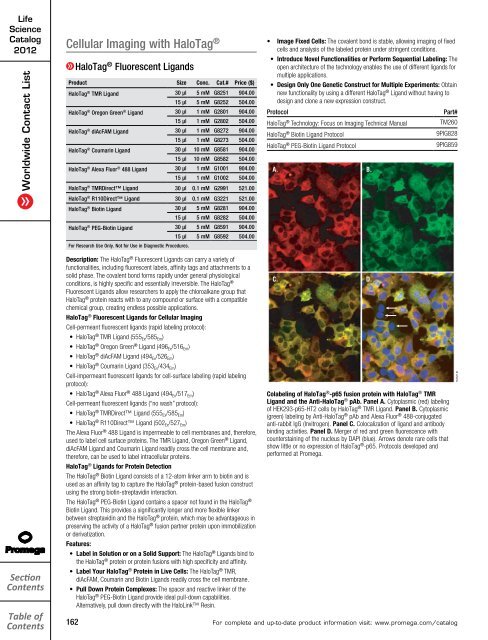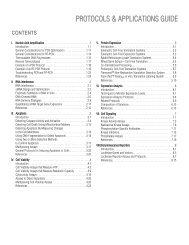2012 Promega catalogue
2012 Promega catalogue
2012 Promega catalogue
You also want an ePaper? Increase the reach of your titles
YUMPU automatically turns print PDFs into web optimized ePapers that Google loves.
Life<br />
Science<br />
Catalog<br />
<strong>2012</strong><br />
Worldwide Contact List<br />
Section<br />
Contents<br />
Table of<br />
Contents<br />
Cell Signaling<br />
Cellular Imaging with HaloTag ®<br />
162<br />
HaloTag ® Fluorescent Ligands<br />
Product Size Conc. Cat.# Price ($)<br />
HaloTag ® TMR Ligand 30 µl 5 mM G8251 904.00<br />
15 µl 5 mM G8252 504.00<br />
HaloTag ® Oregon Green ® Ligand 30 µl 1 mM G2801 904.00<br />
15 µl 1 mM G2802 504.00<br />
HaloTag ® diAcFAM Ligand 30 µl 1 mM G8272 904.00<br />
15 µl 1 mM G8273 504.00<br />
HaloTag ® Coumarin Ligand 30 µl 10 mM G8581 904.00<br />
15 µl 10 mM G8582 504.00<br />
HaloTag ® Alexa Fluor ® 488 Ligand 30 µl 1 mM G1001 904.00<br />
15 µl 1 mM G1002 504.00<br />
HaloTag ® TMRDirect Ligand 30 µl 0.1 mM G2991 521.00<br />
HaloTag ® R110Direct Ligand 30 µl 0.1 mM G3221 521.00<br />
HaloTag ® Biotin Ligand 30 µl 5 mM G8281 904.00<br />
15 µl 5 mM G8282 504.00<br />
HaloTag ® PEG-Biotin Ligand 30 µl 5 mM G8591 904.00<br />
For Research Use Only. Not for Use in Diagnostic Procedures.<br />
15 µl 5 mM G8592 504.00<br />
Description: The HaloTag ® Fluorescent Ligands can carry a variety of<br />
functionalities, including fluorescent labels, affinity tags and attachments to a<br />
solid phase. The covalent bond forms rapidly under general physiological<br />
conditions, is highly specific and essentially irreversible. The HaloTag ®<br />
Fluorescent Ligands allow researchers to apply the chloroalkane group that<br />
HaloTag ® protein reacts with to any compound or surface with a compatible<br />
chemical group, creating endless possible applications.<br />
HaloTag ® Fluorescent Ligands for Cellular Imaging<br />
Cell-permeant fluorescent ligands (rapid labeling protocol):<br />
• HaloTag ® TMR Ligand (555 Ex/585 Em)<br />
• HaloTag ® Oregon Green ® Ligand (496 Ex/516 Em)<br />
• HaloTag ® diAcFAM Ligand (494 Ex/526 Em)<br />
• HaloTag ® Coumarin Ligand (353 Ex/434 Em)<br />
Cell-impermeant fluorescent ligands for cell-surface labeling (rapid labeling<br />
protocol):<br />
• HaloTag ® Alexa Fluor ® 488 Ligand (494 Ex/517 Em)<br />
Cell-permeant fluorescent ligands (“no wash” protocol):<br />
• HaloTag ® TMRDirect Ligand (555 Ex/585 Em)<br />
• HaloTag ® R110Direct Ligand (502 Ex/527 Em)<br />
The Alexa Fluor ® 488 Ligand is impermeable to cell membranes and, therefore,<br />
used to label cell surface proteins. The TMR Ligand, Oregon Green ® Ligand,<br />
diAcFAM Ligand and Coumarin Ligand readily cross the cell membrane and,<br />
therefore, can be used to label intracellular proteins.<br />
HaloTag ® Ligands for Protein Detection<br />
The HaloTag ® Biotin Ligand consists of a 12-atom linker arm to biotin and is<br />
used as an affinity tag to capture the HaloTag ® protein-based fusion construct<br />
using the strong biotin-streptavidin interaction.<br />
The HaloTag ® PEG-Biotin Ligand contains a spacer not found in the HaloTag ®<br />
Biotin Ligand. This provides a significantly longer and more flexible linker<br />
between streptavidin and the HaloTag ® protein, which may be advantageous in<br />
preserving the activity of a HaloTag ® fusion partner protein upon immobilization<br />
or derivatization.<br />
Features:<br />
• Label in Solution or on a Solid Support: The HaloTag ® Ligands bind to<br />
the HaloTag ® protein or protein fusions with high specificity and affinity.<br />
• Label Your HaloTag ® Protein in Live Cells: The HaloTag ® TMR,<br />
diAcFAM, Coumarin and Biotin Ligands readily cross the cell membrane.<br />
• Pull Down Protein Complexes: The spacer and reactive linker of the<br />
HaloTag ® PEG-Biotin Ligand provide ideal pull-down capabilities.<br />
Alternatively, pull down directly with the HaloLink Resin.<br />
• Image Fixed Cells: The covalent bond is stable, allowing imaging of fixed<br />
cells and analysis of the labeled protein under stringent conditions.<br />
• Introduce Novel Functionalities or Perform Sequential Labeling: The<br />
open architecture of the technology enables the use of different ligands for<br />
multiple applications.<br />
• Design Only One Genetic Construct for Multiple Experiments: Obtain<br />
new functionality by using a different HaloTag ® Ligand without having to<br />
design and clone a new expression construct.<br />
Protocol Part#<br />
HaloTag ® Technology: Focus on Imaging Technical Manual TM260<br />
HaloTag ® Biotin Ligand Protocol<br />
9PIG828<br />
HaloTag ® PEG-Biotin Ligand Protocol<br />
9PIG859<br />
A.<br />
C. D.<br />
Colabeling of HaloTag ® -p65 fusion protein with HaloTag ® TMR<br />
Ligand and the Anti-HaloTag ® pAb. Panel A. Cytoplasmic (red) labeling<br />
of HEK293-p65-HT2 cells by HaloTag ® TMR Ligand. Panel B. Cytoplasmic<br />
(green) labeling by Anti-HaloTag ® pAb and Alexa Fluor ® 488-conjugated<br />
anti-rabbit IgG (Invitrogen). Panel C. Colocalization of ligand and antibody<br />
binding activities. Panel D. Merger of red and green fluorescence with<br />
counterstaining of the nucleus by DAPI (blue). Arrows denote rare cells that<br />
show little or no expression of HaloTag ® -p65. Protocols developed and<br />
performed at <strong>Promega</strong>.<br />
For complete and up-to-date product information visit: www.promega.com/catalog<br />
B.<br />
6312TB
















